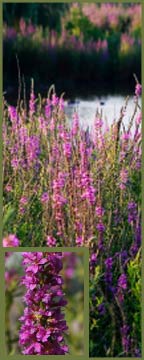Purple Loosestrife
 Lythrum salicaria L.
Lythrum salicaria L.
Purple Loosestrife is a Eurasian perennial plant that was accidentally introduced into North America in the early 1800's.
Description
General: An aggressive perennial, with mature plants having as many as 50 stems per root system and reaching a maximum height of more than 2 metres.
Leaves: opposite or alternate, main leaves 3 to 10 cm long, either smooth or with soft hairs.
Stem: square stem, multiple stems per root system.
Flowers: clusters of flowers with pinkish-purple petals (10 to 15 mm in length) form a spike at the end of each stem. Flowers have short, medium, and long petals and stamens.
Seeds/Fruit: produce as many as 2.7 million seeds annually.
Habitat
Plants can grow in a variety of habitats including wetlands, ditches, lakes, rivers, railway lines, rock crevasses, on gravel, sand, clay and organic soils.
Dispersal
Introduction has occurred primarily through its use as an ornamental. It then spreads primarily by seed but can also spread by laterally branching root stocks.
Impacts
Purple Loosestrife degrades natural habitats such as wetlands and riparian areas reducing biological diversity by out-competing native vegetation. This affects the entire wetland community of both plants and animals. The estimated cost of control, losses and damages associated with Purple Loosestrife is $45 million US dollars annually.
Control Methods
Purple Loosestrife management in wetlands has involved four general control approaches: cultural, mechanical, chemical, and biological. Current efforts in Manitoba focus on the use of beetles (Galerucella calmariensis L.) as a long term biological control. While other control methods have met with little success, the use of beetles has proven effective.
Gardeners can prevent the spread of Purple Loosestrife by removing established plants from their gardens and replacing them with alternative perennials. The entire plant must be removed since it can re-establish from small pieces of root, stalk or seeds. Plant material should be dug out completely and allowed to dry in a container that is protected from the danger of spreading plant pieces by wind, water, animals or other means. Once completely dry and dead, it can be burned or bagged for disposal. Some good alternative plants are native species such as giant hyssop and meadow blazing star.
Report Purple Loosestrife if you see it growing in the wild, in gardens or greenhouses.
Please refer to the Manitoba Purple Loosestrife Project for additional information and brochures, research,biocontrol and management recommendations:
http://www.purpleloosestrife.org
Resource Materials
Purple Loosestrife ISCM Fact Sheet
2011 Rural Municipality Distribution Map
2010 Rural Municipality Distribution Map
Purple Loosestrife MWSA Survey Map
Alberta Plant Council Fact Sheet
Purple Loosestrife — Project Fact Sheet
Best Management Practices 2010 PD
Compatibility of Glyphosate with Galerucella calmariensis; a Biological Control Agent for Purple Loosestrife
Additional Records of Native Insects Associated with Purple Loosestrife in Southern Manitoba
Partnerships and Initiatives in the Control of an Invasive Alien Species
Performance of a Biological Control Agent, Galerucella calmariensis L. (Coleoptera: Chrysomelidae) on Purple Loosestrife in Southern Manitoba
An Integrated management strategy for the control of Purple Loosestrife in the Netley-Libau Marsh, southern Manitoba
Purple Loosestrife Biological Control Programmes in Canada
Â
Back to Aquatic Invasive Species List
Back to Terrestrial Invasive Species List
Â
Â
Â
Â
Â
© Copyright 2004-2025 - CMS Made Simple
This site is powered by CMS Made Simple version 1.4.1


